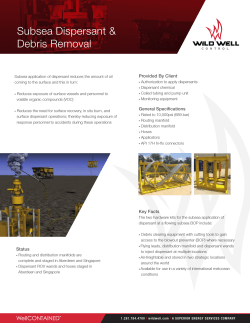
NEBA â new Good Practice Guide
NEBA – new Good Practice Guide Rob Holland, Technical Lead, OSRL © Copyright 2015. Oil Spill Response Limited. Overview ! ! ! ! ! Acknowledgments Background to NEBA NEBA GPG NEBA example Questions NET ENVIRONMENTAL BENEFIT ANALYSIS (NEBA) IS A PROCESS USED BY THE RESPONSE COMMUNITY FOR MAKING THE BEST CHOICES TO MINIMIZE IMPACTS OF OIL SPILLS ON PEOPLE AND THE ENVIRONMENT. © Copyright 2015. Oil Spill Response Limited. 2 Acknowledgments ! OSRL co-authors – Dave Rouse & Rosie Buse ! Industry cohort – Comments and reviews on 2 versions.... – Emotive topic generating lots of viewpoints ! IPIECA – Jo Wilkin & Rob Cox © Copyright 2015. Oil Spill Response Limited. 3 NEBA background – key papers ! Sell et al., (1995) – Science based approach – Case for “doing nothing” ! IOSC Issue Paper (1997) – Jenifer Baker – Benchmark paper ! IPIECA Oil Spill Report Series Vol.10 (2000) – Baker and Lunel – Industry guidance © Copyright 2015. Oil Spill Response Limited. 4 OSR-Joint Industry Project ! OSR-JIP Work Program 12 – 24 new Good Practice Guides – NEBA is one of the key strategy documents alongside Tiered Preparedness & Response and Dispersants ! 30,000ft detail – outreach materials – Glance Scan pamphlet www.oilspillresponseproject.org – Video; excellent overview http://youtu.be/ZwkHe5aqMH4 ! 15,000ft detail - practitioners – New Good Practice Guide – Aligned with Glance Scan – Imminent publication © Copyright 2015. Oil Spill Response Limited. 5 NEBA GPG ! Uses navigational guide for document structure 1. Evaluate data • Oil properties, modelling, sensitivity data 2. Predict outcomes • Baseline environmental impact • Ecological and socioeconomic impacts 3. Balance trade offs • Stakeholder engagement and consensus is key 4. Select best options • Optimum response strategy for range of scenarios • Plans, competency, equipment availability © Copyright 2015. Oil Spill Response Limited. 6 NEBA example from GPG ! Exploration well suffers loss of control including failure of the blowout preventer ! Crude oil and gas are released, with the oil estimated to be flowing at 3,000 m3 per day – – – – – – 1,100 m depth Surfacing oil drifting towards the shore 15 knot prevailing wind and surface current Subsea current runs parallel to the coast Wave height ~1.5m Inshore resources at risk: • • Fishing grounds Seagrass beds in shallow water – Coastal resources at risk: • Estuarine mud-flat that supports a large population of wading birds • Offshore island supports a seabird colony • Three popular tourist resorts in the vicinity © Copyright 2015. Oil Spill Response Limited. 7 NEBA example continued ! Evaluate data – Modelling = 80% probability shoreline impact after 4 days – Up to 10,000 m3 per day of emulsified oil threatening the coast after 4days ! Predict outcomes – The near shore and coastal sensitivities are very high – Protection from oil would result in a high environmental benefit – Estuarine mud-flat is biologically productive and difficult to either protect with booms or clean-up if oiled – Seabird colony does not contain threatened species but adds to the attraction of the area for tourists, with daily boat trips – Tourist resorts are a major part of the regional economy, relying on popular sandy beaches and water sports – Tourism is seasonal but this scenario falls within the main season. The threat to beaches would cause significant immediate disruption and has the potential to dent confidence in the area and reduce future reservations – Inshore fishery is locally important but economically small in relation to tourism © Copyright 2015. Oil Spill Response Limited. 8 NEBA example continued ! Balance trade-offs – Mechanical recovery or in-situ burning alone = insufficient – Oil is amenable to dispersant use prior to emulsification, 24h window of opportunity – Rapid spread and fragmentation of surfacing oil poses mounted response challenges (aerial and surface mounted) – Boat spray system with 5 m3 on site; Aerial application system within 24 hours; up to 100 m3 per day – Subsea dispersant injection system - to commence within 7 days – Subsea injection would greatly increase the targeting of the dispersant operation, the volume of oil surfacing and VOCs at surface for responder safety – DOR of 1:50 or less with subsea = reduces total volume of dispersant used per day – Surface dispersant application could be scaled down or even stopped – Subsea dispersed oil could pose a heightened risk to pelagic marine life, primarily within a few kilometers of the well location – Dilution of dispersed oil would • • • Reduce concentrations to below toxicity levels in the wider area Enhance biodegradation Greatly mitigate gross oiling of the sensitive coastal zone © Copyright 2015. Oil Spill Response Limited. 9 NEBA example continued ! Select best options – Initial surface dispersant use on the floating spilled oil, followed by subsea injection as soon as it can be mobilized, would be effective and be the primary response tool – Inshore containment and recovery operations would be mobilized and targeted around the ecologically sensitive areas – Shoreline cleanup would be carried out around the sandy tourist beaches © Copyright 2015. Oil Spill Response Limited. 10 Any questions? © Copyright 2015. Oil Spill Response Limited. 11 © Copyright 2015. Oil Spill Response Limited. 12
© Copyright 2025












